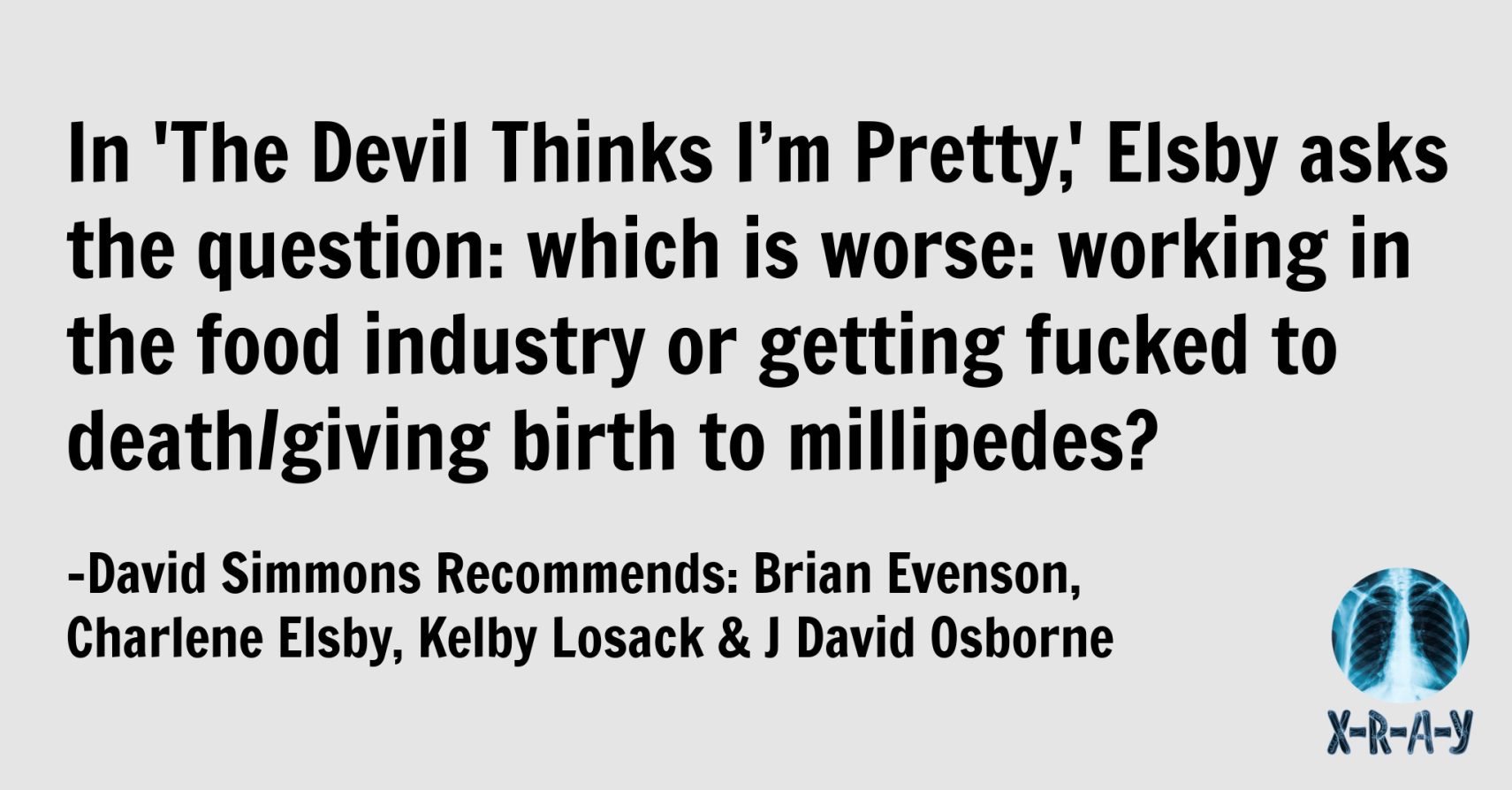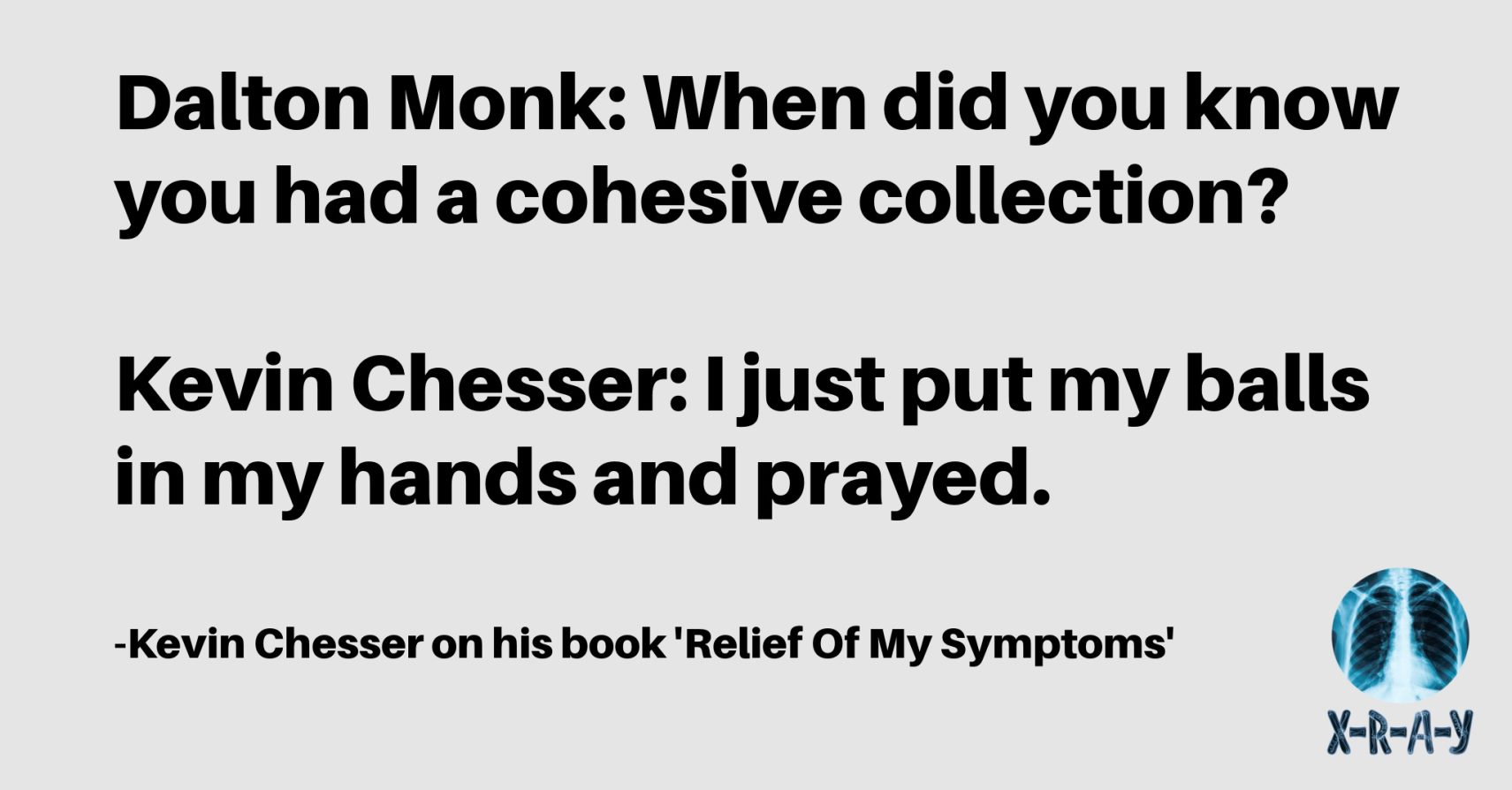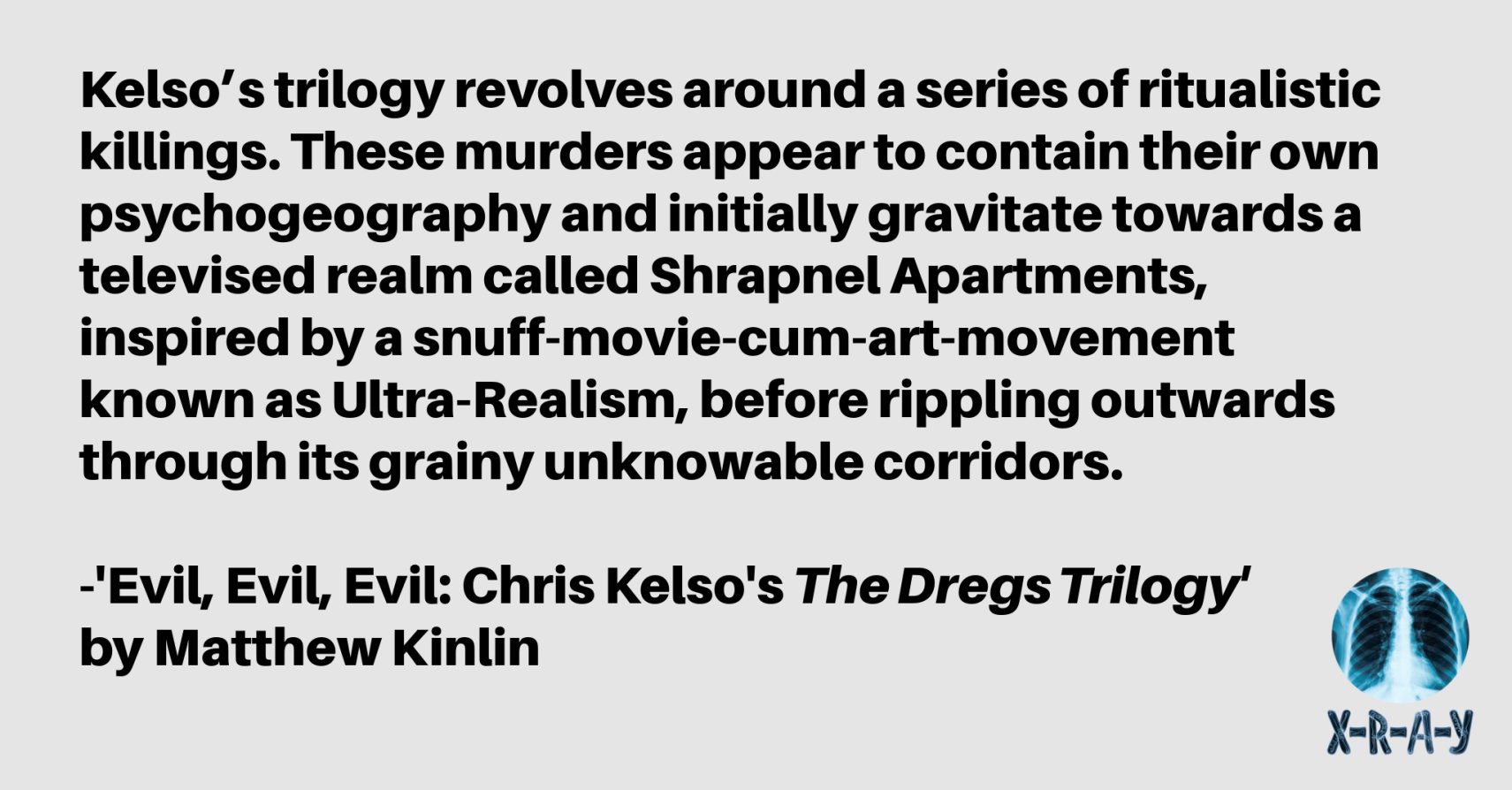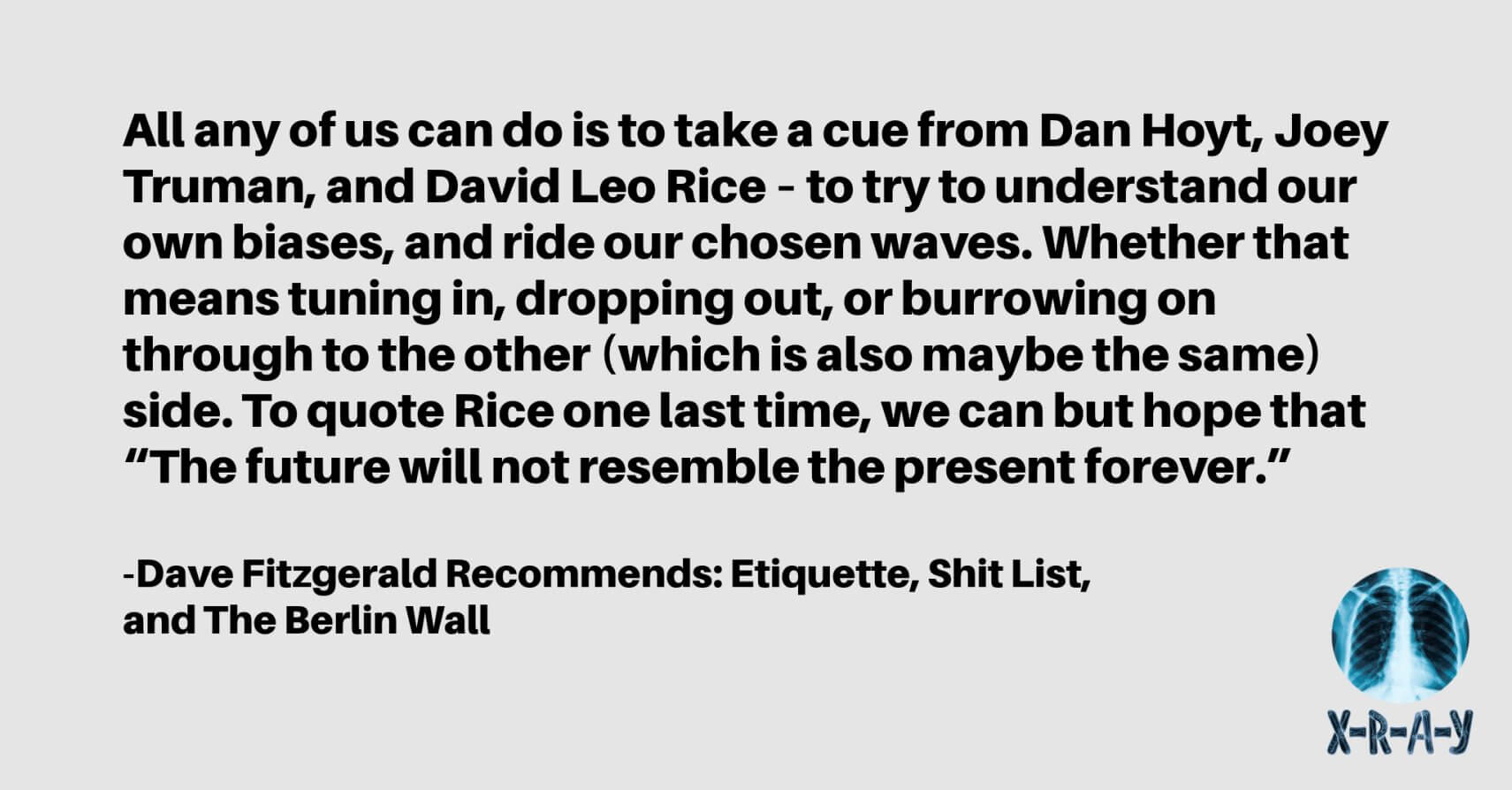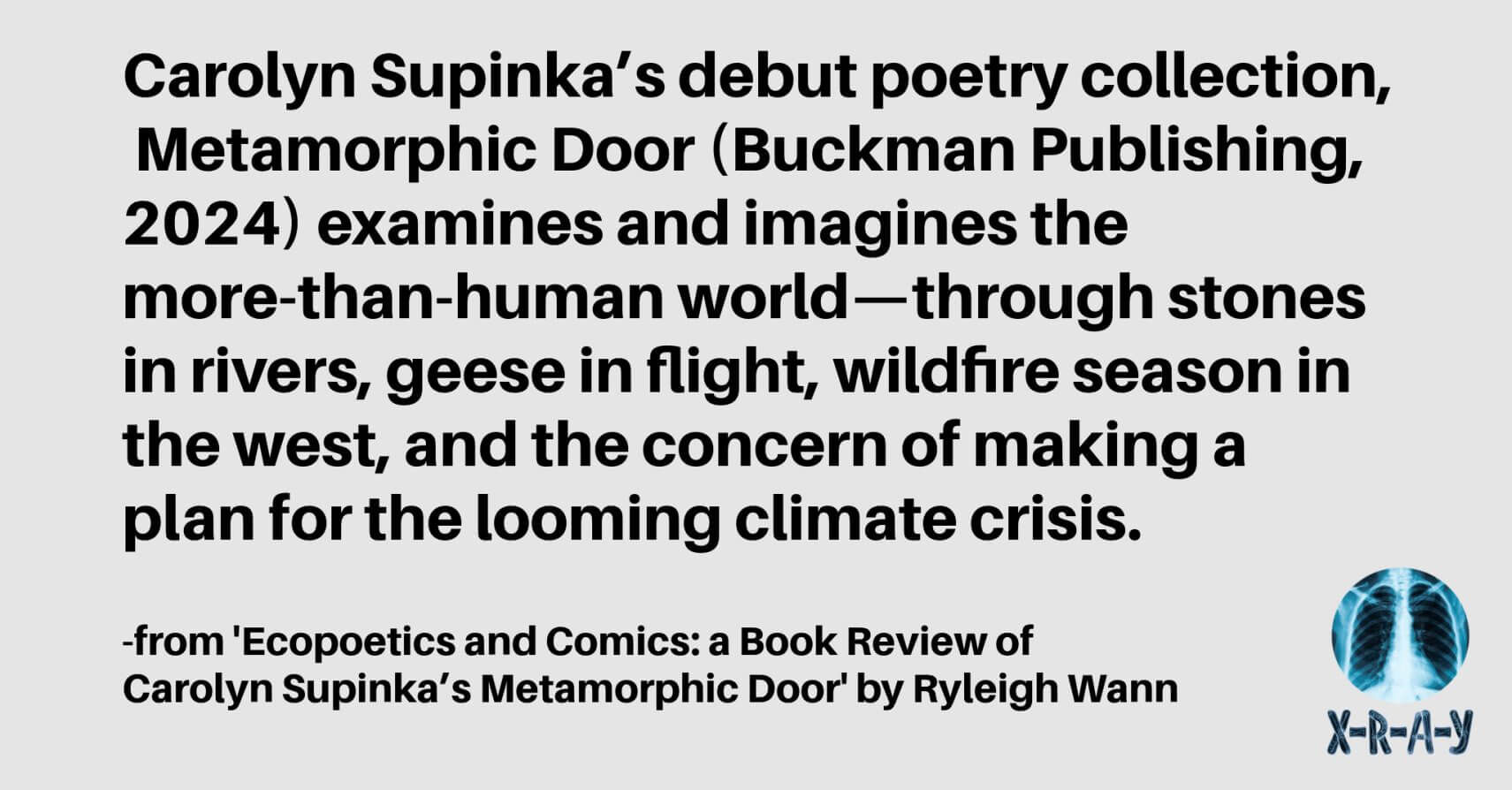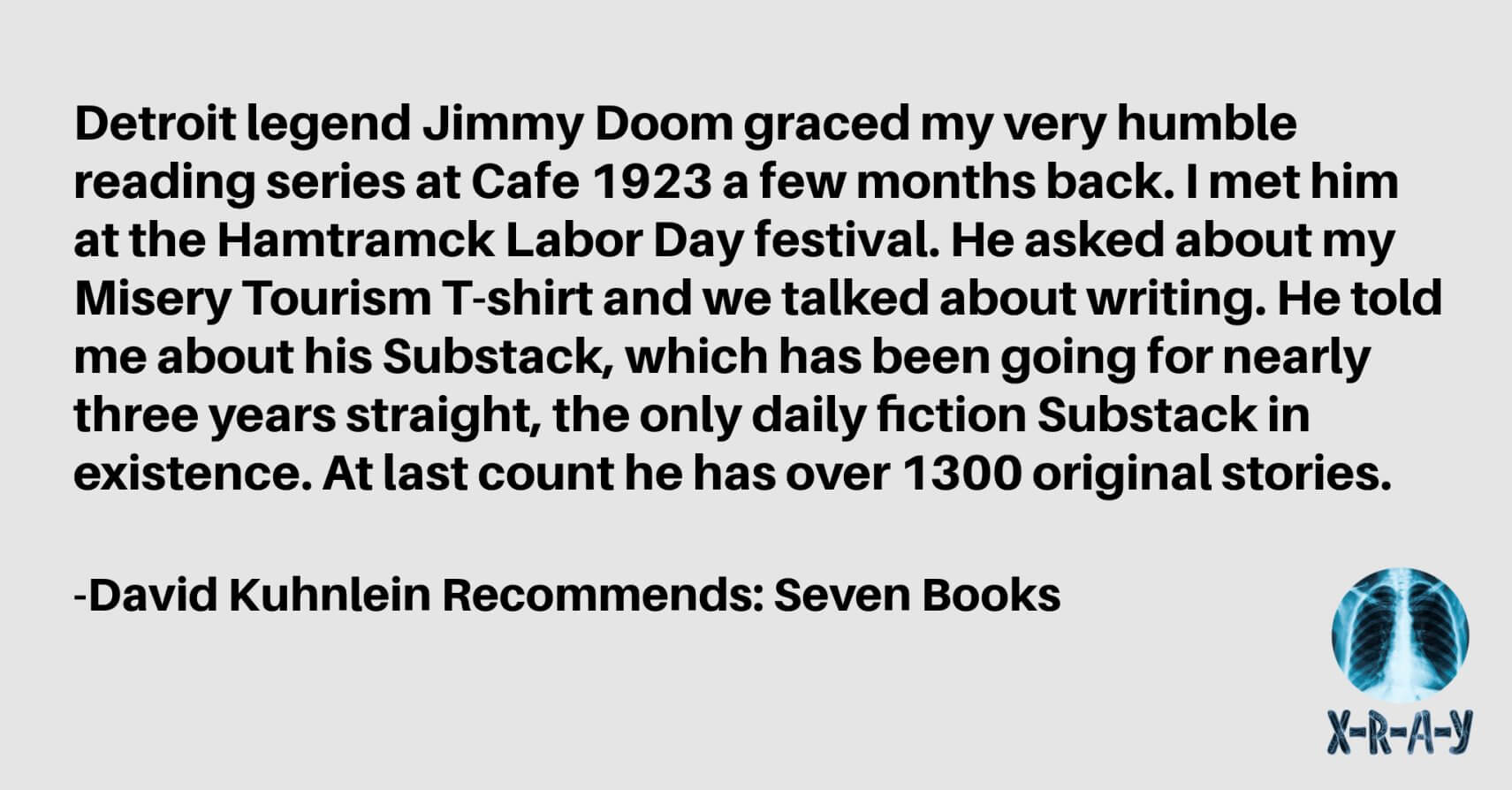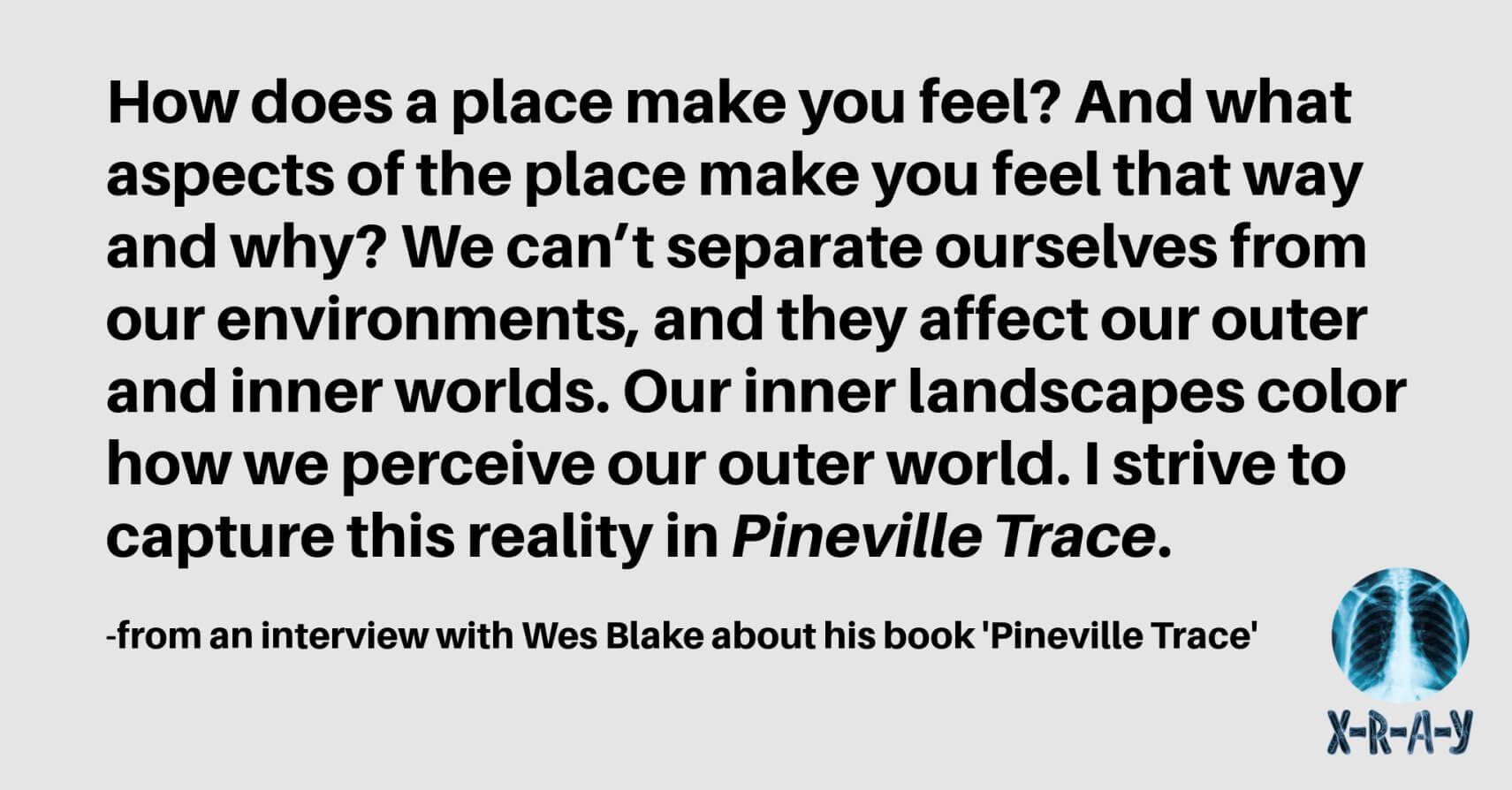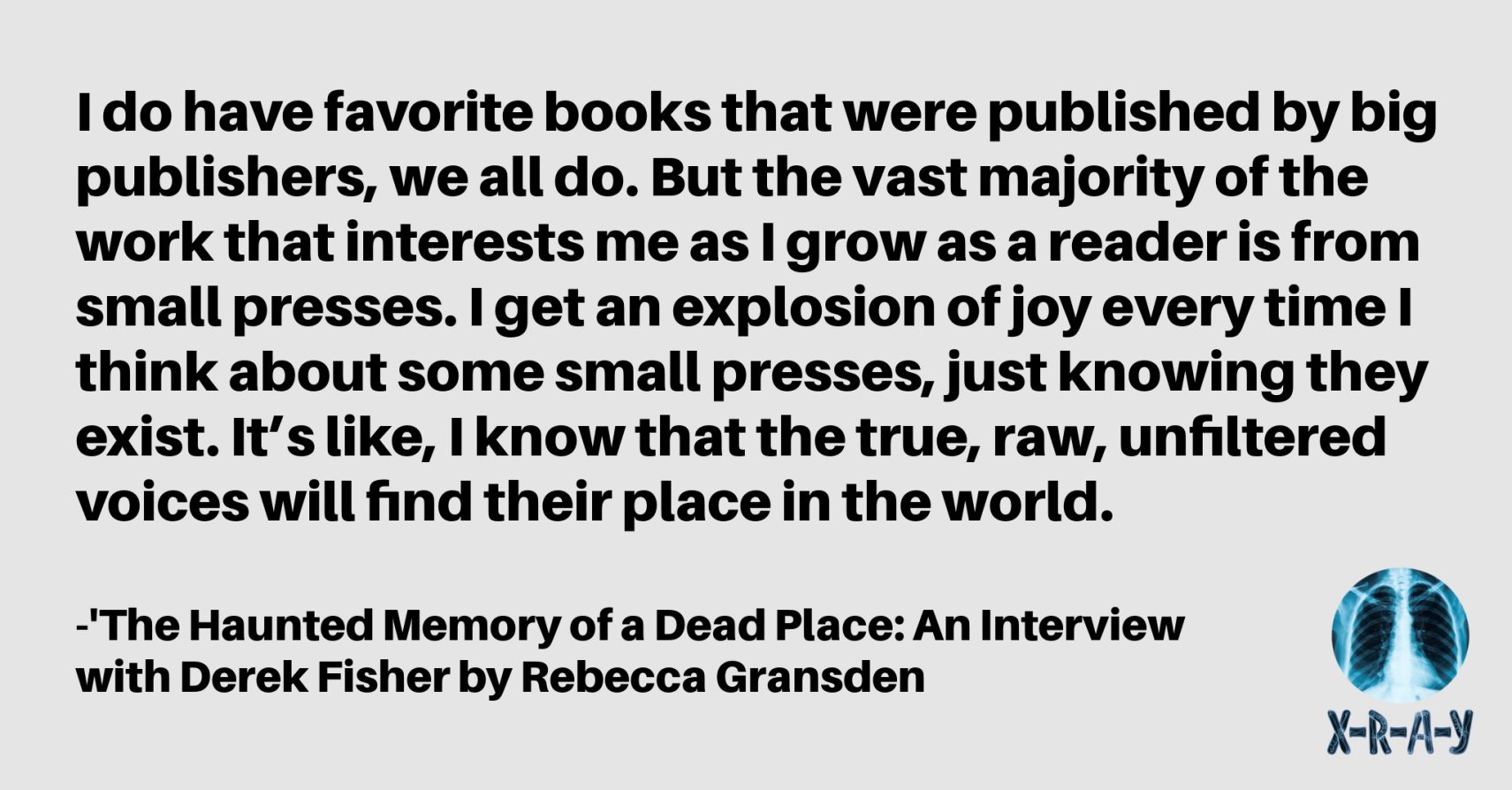
THE HAUNTED MEMORY OF A DEAD PLACE: An Interview with Derek Fisher by Rebecca Gransden
Is there something up with modern dread? Derek Fisher’s enigmatic collection Container (With an X Books, 2024) strokes the lid of contemporary malaise, and teases the release on stories that simmer like a broiling pressure cooker. This is writing cast adrift on strange currents, Fisher’s domain that of diseased architecture, where dark impulses meet bad vibes. I talked to Derek about this unsettling and dynamic collection. Rebecca Gransden: When did you write your first short story? Has your approach to the short story form evolved over time?Derek Fisher: Yooo. Hi Rebecca, my fellow Lizard Brain!My first short story, like ever? Uhhhh, I think I was in high school. I remember submitting little weird things to my high school’s annual short story publication. A couple of them got in. Then I was supposed to join everyone that got tapped and do a reading at a nearby bookstore and I most definitely did not show up. No way I was reading in front of people back then.For a while I wrote stories based on what I thought readers might want, based on what kind of style and voice trends you’d see in literature. Don’t do this. It’s the ultimate bad move. Over time I think I stopped caring about what the work would look like to others, and just wrote the stories I wanted to write. I found myself writing in a handful of approaches to voice and style that started to feel like my own. There are a few stories in here where the paragraphs are all blocks of text, no indentation. I write with this format more and more, as I find it tends to drive this ominous tone that I’m usually gunning for. Something about the fragmentation helps conjure the spooky vibe. I also think nowadays my stories are getting shorter. Soon they’ll just be two sentences long. “Jim went to the store to buy a bag of Milk. The severed fist was still in his ass. The end.” RG: The collection shares its title with one of the stories included in the book. What led you to select Container as the title for the collection as a whole?DF: For the longest time I wanted to name the collection I’ll Only be Happy Once Everything is Gone, and had submitted previous versions of it with that title to other presses. But I hadn’t written the story “Container” at that point. Then one day that story spewed out and it was obvious that it would be the title track. I love that goddamn story. The way it grips tight like having your whole body wrapped violently in duct tape. That’s the feeling I get when I think of that story, so it seemed like alright why not just call the book that and hope the whole collection feels that way? Try to convince the reader that the whole thing carries that same tightness through the title, haha. Gotcha. That story deals with desire on the verge of rupture. It takes place in constricted spaces. Cars, elevators, storage rooms. And maybe more than anywhere else, inside the obsessed brains of these two characters. Their thing threatens to rip open at the seams. I think the story itself feels that way, like it’s just barely contained. I really like this story. I think it constricts us into these spaces. Confronts us with the lust or obsession or self-erasure or whatever flood these characters find themselves in. RG: How old is the oldest story you’ve included in Container, and how new is the newest?DF: The oldest is “Scorch Earth.” I probably wrote that in late 2019, early 2020. The newest is “Rhino.” I wrote that like two seconds before I sent the collection to Jon at With an X. It came out in La Piccioletta Barca after the collection had been accepted. RG: The stories featured in the collection have appeared at a wide variety of literary venues. How did you go about selecting which pieces to include?DF: I went back and forth forever on what to include and where to stick ’em. The stories “David Lunch” and “Rhino” were last minute additions. The title story came fairly late in the game too. “Scorch Earth” and “Bird Eating Glass” and “I’ll Only be Happy…” had been around in the hard drive’s basement for a little while but I always knew those stories would be part of the deal. Whether or not they had been previously published didn’t factor in too much. It took me a while to figure out the order. That’s a fun exercise. Rearranging the pieces until they feel right, or as right as they’re gonna feel. I wasn’t sure about including the flash pieces at first. But then I figured who doesn’t love a one-pager? Easy work. Throw them in! I’m always interested in how writers arrange a story collection. Feels similar to how the tracks come together on an album. Or a set list at a show. Sometimes you read a collection and you just know why the final track was picked to close the show. Two of my favorite collections in recent years are Maggie Siebert’s Bonding and Sara Lippmann’s Jerks. Two entirely different gems. In both cases, you get excellent collections all the way through. But then they both end on such strong notes that it changes the complexion of the whole thing. In both cases, these final stories (Siebert’s “Every Day for the Rest of Your Life” and Lippmann’s “The Polish Girl”) imprinted the joyous experience of reading the collection with a perfect, final sledgehammer to my ribs. You don’t forget a thing like that. Good curation can sew the feeling of a story collection to your skin. That’s what I want to feel when I’m done reading a book. That, or a feeling of “What the fuck did I just read?”RG: In “Bird Eating Glass” you present a character named Mantle, who is a musician swept up in the modern fame game. For them, sound brings renown, brings the noise, brings powerful recollections and associations. Are there particular sounds that flood you with memory?DF: I constantly hear the sounds of trains in my head; that braking screech, of the train pulling into a station, or possibly derailing. I don’t know what that’s about. Like I have a subway stop full of dead people living in my skull or maybe in my house behind the wall like in that Robert Munsch book Jonathan Cleaned Up and Then he Heard a Sound.At all times I feel like I am hearing dead static, or electric feedback. Should probably get that checked out, right? Like someone is holding a microphone to an amp. I don’t know if I literally hear this, but it’s there in my head. Probably just been to too many shows. I enjoy it. It tunes out the world for me, which I don’t mind at all. I have what I think is a problematic compulsion to repeat songs in my head all day long. But not necessarily because they are catchy. Lesser Care’s “Finally Bare” has been on constant repeat in my brain for three or four weeks. I’m totally haunted by this song and I am losing my mind. It’s a good song! I enjoy it very much. But sounds and music often turn compulsive as they repeat for me. Every song I’ve ever heard just gets added to the jumble of infinite repetition. When I stop to think about all this constant music in my head I think I must have a tumor or a serious neurological problem. It hasn’t killed me yet so I guess it’s probably fine but who knows. I always write with music on. Silence drives me crazy. Unless I’m beside someone I love. Then I can be ok with quiet. Their breathing is enough. Otherwise, I need sound. Mantle, in “Bird Eating Glass,” is the manifestation of this part of me. I’ve never played music, but I can’t live without it. Sound informs my ability to make stories. Mantle is what a character would look like if they were stripped of everything but sound-driven compulsions. An expression of pure noise, otherwise locked into the body and mind of a human. I think people can relate to the idea that our internalized noise not only has value to us, but is a reflection of all the sensory mania we absorb, and can be filtered into something quite lovely. The world is a fucked up place, right? Mantle’s noise is the meeting point between the world, and total sonic isolation forced outward. The conceit of the story is that harsh noise can become the world’s most popular art form. I am 100% confident that this is true. It’ll just take the right artist to deliver us. RG: The story “Scorch Earth” makes repeated reference to a purpose-driven life. What does a purpose-driven life look like to you, and how does that manifest in your writing life?DF: If you asked me this question four years ago I would have had a whole spiel about how writing is my purpose and how my life is driven by it and as long as I have writing goals I’ll be fulfilled or some blah blah blah like that. But I’ve calmed down a lot with that shit. I don’t know if life (mine or anyone else’s) is purpose driven. I just do things I guess. Write, eat, work. I really like eating. Sometimes I watch these competitive eater YouTubers and think I should do that. That can be my purpose. To eat. Consuuuuume. Lily in “Scorch Earth” is a smart cookie but at the start of that story she’s still too young to understand what life means as something separate from her parents. She believes in a “purpose-driven life” but doesn’t fully appreciate the fact that this idea has been dictated to her from birth. I think there’s an undercurrent of spirituality in that story, where her parents probably believe that by killing, by devoting their lives to the pursuit of taking life, they are somehow closer to god, or the devil, or whatever nasty thing they worship. We don’t see this translate into Lily. She does not show signs of spiritual belief in pursuing her victim. She lives this purpose-driven life because that’s what she’s been taught to do. Sometimes this is how I feel about the rhetoric around this idea of purpose, that we are being fed a pseudo-spiritual concept and that if we live with purpose, we will be complete. But the more I think about this as something dictated to me, in YouTube videos or podcasts or whatever, the more it feels like snake oil, and just fodder for boot-strap narratives that exist only to feed the machine of capital. My true belief is that people just do things. We just do things. We will always do those things. Whether we like it or not. They are coded into us, and/or the influences around us lead us to do things. Eat, drink, lie, steal, kill, love, donate, write, play, serve, worship, make annoying sounds for no reason, travel, do drugs, smash our teeth out with a hammer, whatever. RG: I found many of your stories to be governed by strong undercurrents, as if the crux is brimming beneath the surface. This gives the pieces an enigmatic quality. Is this element one of conscious intent?DF: Oh, thank you! I like hearing this. It is conscious yes, but I never know if I’m doing it well. I am a giant fan of subtext in fiction, and so I prefer to try to work with undercurrents as opposed to surfaces, but I also like to write stories that are more vibe-driven than plot-driven, so I think these undercurrents you identify are part of my attempt to encourage certain vibes more than anything else. I’m a big fan of dread. Apocalyptic nothingness and the haunted memory of a dead place. Memory is the motif I’m obsessed with most. Almost all my stories are about memory. Humans are made of memory. I think these undercurrents are all attempts to explore the memory of a place, relationship, moment, etc. Often memories are haunted and uncanny. I like to try to get at these feelings in the subtext.I think about how this applies in the story “Progress.” The meat of the story is the dialogue between TurtlePhone and Positively Pete! It seems like such goofy shit. A smart-ass talking toy turtle with the mind of an up-his-own-ass PhD student and who also believes he’s a special ops super-killer. It’s probably obvious that I had a lot of fun writing this. But the part of the story I’m most drawn to is the abandoned, scorched shell of the town of Baker, California at the end. What happened here? Why this apocalyptic graffiti? What haunted hell is this? In some ways I see all the dialogue and silliness of the story as a colorful vehicle to get us to this apocalyptic end, this haunted memory of a place that existed until recently. As a reader I just love seeing and thinking about undercurrents. Kazuo Ishiguro’s The Remains of the Day is one of my absolute favorite books, because of how it tells a rich story entirely in the subtext. Laura Van Den Berg’s collection What the World Will Look Like When All the Water Leaves us (I just typed that whole thing without Googling it) is a goddamn masterclass on subtext. Both of these books deal with subject matter that isn’t of high interest to me; both are books I stumbled on, but quickly came to love because of how strikingly they channel what’s below the surface. I don’t care so much about craft. Sure I like to see talented writers throwing down some nice moves, like watching elite athletes do their thing, but that’s relatively low on the list of things I look for in writing. But with subtext, different story. When I see a writer do subtext well, I get the full body shiver. I think Hemingway said a good writer doesn’t say what’s happening on the surface, but they have to know those details, and like, by knowing, the reader will get some kind of a sense of truth, a conveyance, even if they aren’t made explicitly aware of the details. I say, fuck off Hemingway. Don’t tell me what I have to know. I don’t know what TurtlePhone is up to when he’s sitting on the can. That’s his business. RG: “Does Anyone Care How the Vegetable Oil Feels?” describes a technique you call method writing. Any examples of this in your own writing life?DF: Haha, no way. I used to think this idea was attractive as hell. To live the shit hard, as the narrator in the story says. But that sounds like a goddamn nightmare to me to be honest. I guess some nightmares produce some good writing. But it’s never been that way for me. I just have ideas and write them down and hope they work well enough. I think the idea of the artist living their art as authentically as possible is sexy to us, but it has problems. If we exoticize and romanticize all the violence, addiction, desperation, and evil that we see in our literary heroes, that forces us into a confrontation with our own values that I don’t think we particularly want to have. As someone who loves wretched characters, it’s a place I hesitate to go. I think of Al Swearingen in Deadwood, a magnificent TV character. To come up with a character like that I might have to become a murdering, deceiving, totally self-interested pimp? Well, shit. That sounds like a lot of work. I remember reading Knut Hamsun’s Hunger, about a literal starving artist, a favorite book of mine, thinking God damn! this poor bastard. Someone shoot his ass and put him out of his misery. Hamsun really lived off fumes, nearly starving to death in his early days. I guess Norway wasn’t so rich back then. Then he got big and famous and won a Nobel Prize and eventually became a Nazi sympathizing maniac. A bunch of them went this way. Celine. Eliot. I just want to write stories.I will say, I do gush at some examples I hear about of writers doing insane shit in order to conjure their art. Like Gary Shipley watching Begotten on repeat in a dark room for two straight weeks to write You With Your Memory Are Dead. That is the most batshit thing I’ve ever heard. Or, sticking with Inside the Castle books, their Castle Freak projects, where the writer has five days to write 100,000 words. These feel like experiments in what we might call method writing, putting our minds and bodies through extreme ordeals in order to test our creative limits and access the most unhinged, terrifying depths we got. I wish I had the discipline to attempt maniac stuff like this. I’d probably produce 75 words about stoned beavers wandering around the forest looking for wood. RG: The office building is the tallest, thinnest in the city’s history. A man plummets to his death on the first day it is occupied, the day after completion. The sounds of children screaming are heard in the elevators, in the stairwells. On several of the floors. Throughout meetings. It’s much worse when the wind hits the building. A feeling of nonstop vertigo defines daily office life. The above quote from “Rhino” is a prime example of the ominous quality you can inject into environments. How do you use location when it comes to building atmosphere?DF: I think I’m obsessed with the haunted potential of a space, interior or exterior. I want to feel the imprint of a place, I want others to feel it. We might not know what happened in an empty room. Maybe nothing. Maybe somebody was tortured. Maybe a plot to commit a mass atrocity was concocted in that space, in a basement, over tuna sandwiches and old moldy coffee. Maybe all kinds of unthinkable things happened in this little desert town that used to function well enough, but is now burnt to the ground. I like trying to think about what a place feels like to someone stepping into it, and they know bad things have happened there, but they don’t necessarily know what or how or why. I think “Rhino” is about the design of haunted places, as if their hauntedness was intentional, built into the space, rather than the space becoming haunted after the fact. The story seems to connect this spooky business to Lorna, the architect who designs them, as if she is the haunted one, and everything she touches turns to death. But we don’t know why. Is she plagued by this herself, or is she some kind of a demonic figure sewing chaos, getting off on diabolic design? I enjoy trading in uncertainty with these kinds of questions, and letting the reader decide. My first job outta undergrad I worked in a big ad agency. Way up on the 32nd floor. Could see the whole city. I had a meeting with one of my bosses and I can’t remember why but I started spouting off the heights of all the tallest buildings in Toronto. She said, “Uh, Are you… into buildings?” I said no, all embarrassed. But the truth was hell yes, I am. I am into buildings. All their vertical pathways and tunnels, elevator shafts, unseen dark corners, crawl spaces. I’m afraid of heights. But I lived on the 25th floor for years. All tall buildings are haunted spaces to me. The wind sounds like a screaming animal up there. All day, life accented by constant screaming. RG: Your exploration of unconventional romance, featured in “Container” and “For Whom I Bare My Teeth”, presents an intense and, I found, cinematic take on sensuality. What is your approach to erotism in your work?DF: Hmmm, I don’t think I have an approach exactly. These stories are about desire. I think desire is dark, by its nature. I wanted to find ways to show that, but without being too on the nose. “For Whom I Bare My Teeth” is a bit more straightforward about it, but I do find that story to be funny, and maybe less serious about the darkness of desire. At least that’s how I felt writing it. I suppose cannibalism stories will always be funny to me. I really enjoyed writing both these stories, but they came from very different places. “Container” feels more serious, like it’s reflecting on something where for the characters the stakes are sky high. I don’t know if in other stories dealing with erotism I would use similar approaches. I just recently finished writing something about a couple so obsessed with each other that they begin to literally eat each other. There I go with the cannibals again. But the approach there is different from these other ones. I guess I just try to channel a question about what these characters’ desires look like, and what would happen if they took those desires to extreme, unreasonable places. I’m interested in making the unreasonable feel real, necessary. Unreasonable but necessary. Unavoidable. Impossible for them to avoid going there. Maybe that’s the approach. RG: I remember when the terminally ill artist Anastasia Pelon brought her whole family to Neon for one last dinner together. We had been expecting a room full of eccentricity, full of chaos, full of the infusions that such a prominent artist would have inevitably left on her closest family members, especially in the shadow of her imminent death. But what we got was something much different; a room full of working-class, down-to-earth, polite people, who all happened to be this woman’s family. There was never an unsmiling face around the room. These parents, siblings, and cousins were so happy to be together. Anastasia’s sister helped her whenever she needed to use the bathroom or stretch her legs. Her sister would carry her oxygen tank as they walked together, holding each other’s arm. I remember the expectation that the whimsical and ferocious aesthetic that imbued her art would reveal itself in the room, but no. The bloody, bodily, confrontational, qualities of her work had no role here.The above quote is lifted from your story “Neon”. What has surprised you about the collection, either in the writing of it or in the process of releasing it to the world?DF: The fact that I have ever published one word of writing surprises me every day, let alone a whole collection. RG: The elevator appears as a recurring motif in the collection, frequently as an uncanny space. Do you have any insights into why the elevator is attractive to you?DF: You caught that eh? I hadn’t anticipated a question about elevators, but I am happy to see this. I do think about them a lot. These steel boxes in which we spend a significant amount of cumulative time, those of us that live or work in tall buildings. The elevator is removed from the rest of the world. Such uncomfortable little moments can happen there. Yet such significant moments too. They test our humanity. Small talk. Claustrophobia. Fantasizing about the terror of being stuck in one. I’ve met people in elevators that became significant in my life. I’ve watched dogs piss and shit in them. In the height of the pandemic, the elevator became this place of mania, paranoia, and uncertainty. And total crushing awkwardness. Infection. All of these things factor into how I think about the floating steel box that hides us from the world for a couple minutes.I think elevators are crazy places. Intense, crazy places. Have you ever ridden in an elevator and had someone you don’t know stare at you the whole time? I picture the cables being cut, and the box plummeting. Everyone crushed inside. Impaled with shards of splintered steel the size of swords. I don’t think about this kind of thing when I’m in cars or trains. Something about this closed box brings these thoughts. No windows. Closed off from the world. I picture people in the elevator unable to control themselves. Strangers so attracted to each other at first sight that they tear each other apart. They know they are on camera but they don’t care. They know they only have a minute. That others might enter. But they don’t care. Elevators are crazy places. We can think these thoughts, for a minute or two, and then we get off on our floor and it’s over. The thoughts are gone. RG: An undertow of dread and unease permeates your fiction. What attracts you to exploring this area with your writing? What do you dread?DF: I always think back on that Clive Barker story “Dread”, from Books of Blood. The character Quaid is obsessed with dread and experiments on people, forcing them to confront their worst fears. Great story. He leaves that poor vegetarian girl starving in a room with only rotten beef until she’s forced to eat it.There are some great vibes to be mined from dread. The well of dread is endless. The world is a dreadful place. We all are forced to confront dread in our own ways. I don’t always plan to write with dread in mind, but some stories just take on this tone. The undercurrents we spoke of earlier, the feeling of spaces being haunted with memory, this can be a dreadful feeling. Sometimes I do dread by accident because I write a character that is too flat or one-dimensional and in their flat silences there can appear to be things dreadful about them. Whoops, haha. I think the dread in my work tends to come from feelings of insularity, containment. Some of these characters are so locked in their own heads. We only see what they think. The rest is a mystery. I think this can be dread-inducing. They are containers; all we know of them is how they perceive a dying world, experience a violent sexual relationship, look down at the gun in their hand. Sometimes I think of dread as a feeling elicited by the knowledge that the world is filled with monsters that we don’t see. We know they’re there, but they live in the shadows. It’s the knowledge that they exist that breeds dread in us. We know terrible things happen. Murder, torture, human trafficking, genocide. And sure, we see these things on the news. But most of us don’t confront them for real. Most of us. This is of course a good thing, not to have to know these horrible realities first hand. The dread lives in the space between us and the shadow. I sometimes try to write as if considering the monstrous, even if I’m not describing it or writing about it directly. The writing is the empty space between us and the horrible thing. What’s uncanny about it is that we all recognize the smell, the sound of the empty space. We see a recognizable horror in it despite it being empty. That’s why that “Backrooms” picture is so scary. I think this is the driving force behind stories like “Bird Eating Glass.” A character who is plagued by the unfathomable knowledge of the world. This character is a mystery to us. We don’t know what they’ve seen. We just see some whisp of it reflected in their intolerable music, in the scars on their face, in their severed voice. The fact that their music happens to be popular in spite of itself is the signal that we all recognize the terror in this empty space. You ever read Grace Krilanovich’s The Orange Eats Creeps? I think that is the best book ever written about dread. RG: “Reasons to Stay” addresses the vagaries and vacillating tensions of a relationship forced to factor terminal illness. How did you decide upon the approach to structure for this story?DF: This story is pretty much entirely based on a true story. I don’t love to admit this, because doing so interferes with the pretense of fiction from which I feel we must always approach books billed as such, but in this case I make an exception. I’d been trying for a couple years to find a way to write about the person that “Reasons” is about and I kept coming up flat. I tried much longer works that were more formally conventional, but hated all of them. Then one day I sat down and wrote this and it just felt true. I like to think of this story as being pretty good at expressing what memory feels like – all broken up and fragmentary and mixed up between the good and the painful. I didn’t exactly set out to write the story in this fractured way, it just came out like this, and I knew that it was the real story as it was coming out. It ended up being much shorter than any of the previous versions, which also felt correct. My memory of this relationship feels compressed and frenetic, hard to pin down yet clear as day in some parts. My memory is engraved with ambivalence and longing, but as time goes by, those elements are further compressed and reordered, slotted into this larger chaos that is the sum of all memories. I wasn’t thinking any of this as I wrote it, I just wrote. And then after the fact, it just made sense that my mind was processing these feelings and memories through this fragmented ambivalence. I don’t know if any of that shit makes any sense but I think it makes sense to me. RG: Container is released by With an X Books. Why have you chosen to work with them for this collection? In a wider sense, how do you view the small press scene?DF: It has been a total pleasure to work with Jon and Traci at With an X. They are so diligent, generous, and professional, I could not have asked for a better experience. I had an intuitive sense that With an X might be a good fit for a couple reasons. I felt that the vibe of some of their books of photography connected with the tone of the title story “Container,” in an abstract but not insignificant way. As it happened Jon had read that story previously when it was first published in Maudlin House, and said he was taken by it, so I think there was already a seed planted there, unbeknownst to me at first. I also felt that a previous collection they’d published, Drew Buxton’s So Much Heart, had some similar sensibilities to my work, the mixing of the real and the hyperreal, some darker stuff but not lacking in heart, that the vibe felt right. Far as I’m concerned, small presses drive literature. A few weeks ago I drove to Portland from Vancouver just to go to Powell’s. I spent like three hours in the small press section, examining every single book. Anyone watching me woulda thought I was a lunatic. Dennis Cooper always says that all the best writing in the world comes from small presses and he’s ten thousand percent right. I love the small press scene. I couldn’t live without it. I do have favorite books that were published by big publishers, we all do. But the vast majority of the work that interests me as I grow as a reader is from small presses. I get an explosion of joy every time I think about some small presses, just knowing they exist. It’s like, I know that the true, raw, unfiltered voices will find their place in the world. The most uncompromising writing is available to us because some of these small presses exist. I am eternally grateful.RG: “Do I fear for the future? Hell fucking no I don’t. Hell no. You know why? Because fear is dumb wasted pussy shit that serves no purpose. That’s why. We’ll figure this out like we figure everything.”Do you think about the future? If so, what does the future look like to you, with regard to your writing, or anything else?DF: Oh ya, I think about the future. I think about it all the time. I think about burnt buildings penetrated by hollow winds. I think about cities washed away by floods. I think about vast landscapes marked by emptiness, with little fossilized remnants buried beneath the surface, hidden signs that we were once here. I love thinking about the time beyond the end of us. It gives me a blissful chill. I don’t care if that’s a cliché. I don’t like being told not to be cynical. I embrace feelings of cynicism and nihilism. I don’t care if they absolve me of having to work for a better future or not. I don’t care if it is a privileged position to think like this. It’s just the way it is for me. I get creative fuel from thinking about what the world looks like when we’re gone. I also think about all kinds of nice things, future-wise. But I keep that shit to myself.

